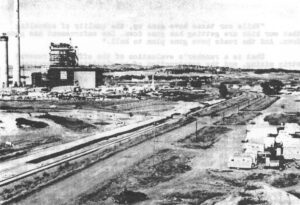The sudden rise in the price of crude oil two years ago provided the stimulus for serious consideration and allocation of funds — for the development of alternate energy sources. The initial antagonism between environmentalists and the energy industry has abated somewhat, although pressure to lower clean air standards, speed up construction of nuclear power plants, and to accelerate strip mining and offshore drilling are still top priorities of the oil and utility industry, and of the Ford Administration.
But a significant development is the change of attitude within government and industry concerning alternate energy sources. For the first time the idea is being taken seriously, and both private enterprise and government agencies are moving quickly to get in on the action. For the amount of money that will be spent on energy research and development over the next two decades is phenomenal.
Atomic energy remains the first priority. Responsibility for researching and developing solar power technology, the most promising alternative to atomic and hydrocarbon sources, has fallen to the Energy Research and Development Administration. ERDA is assuming the roles previously held by the National Science Foundation, and the National Aeronautic and Space Administration.
Other government agencies are now struggling to get into the energy program — the hottest game in Washington. These include the White House’s own National Energy Board, the Atomic Energy Commission, the Commerce Department, the Federal Power Commission, the Environmental Protection Agency, the Interior Department, the Tennessee Valley Authority, and even the Office of Management and Budget, which controls the purse strings.
During the coming years, ERDA will determine where most of the federal money goes for energy research and development. Solar energy development will receive about $50 million this year — almost four times the amount spent on solar research in 1974.
During fiscal 1976, the Administration plans to spend more than two billion dollars for energy research. About 85 per cent of this money will go to nuclear research — including weapons — but the relative increase of spending on other sources of energy will be much greater than nuclear.
Coal research and development will grow by 60 per cent, advanced energy systems by 89 per cent, geothermal by more than 100 per cent, and solar by 550 per cent. Nuclear power research will increase by only 10 per cent, and that increase is mostly to keep up with the rate of inflation. Nuclear power remains the big gun, but some priorities have shifted. ERDA seems determined to dissociate itself from the nuclear label.
Money for research and development of coal — a much faster and more certain energy source than the new technologies — does not match that, being spent on other sources. The amount rose to slightly more than one hundred million dollars, 34 per cent of that to be spent on liquefaction, closely followed by low-BTU gasification.
Oil shale research and development is rising by 135 per cent, to $4.6 million, most of the effort aimed at perfecting the processing of oil shale at the point of origin. Although the Interior Department has turned over its energy research functions to ERDA, Interior will curiously receive more funding for energy related projects than has been granted ERDA.
The solar budget for fiscal 1976 — $57 million — may be difficult to spend wisely, considering the lack of knowledge and facilities available. Sixteen million dollars is already committed to implementing legislation for solar heating and cooling passed by Congress. These are the arguments used by the Administration to justify the low priority of solar energy.
In spite of these large figures, nuclear power remains the largest recipient of funds for research and development. A small percentage of the budget will be devoted to such things as energy conservation, and the safety of nuclear power plants. Solar, thermal, and wind power may now be officially recognized alternatives — they have some promise, in the official view — but remain in the background.
Recently in a speech before the House, Representative Charles Vanik — an advocate of full development of solar power — criticized the President’s proposed budget. He pointed out that the largest item in ERDA’s budget is the 30 per cent that will be spent for national security, and is in no way associated with energy research. Only one-tenth of the ERDA budget is devoted to research and development of non-nuclear power-including coal. Less than one per cent of the budget will be devoted to finding more efficient ways to use existing energy.
Excluding administrative costs, almost 80 per cent of ERDA’s budget is directly related to research and development of various applications of nuclear energy. Nuclear safety, a major consideration in full-scale nuclear power development, will account for only slightly more than five per cent of the 1976 budget. And solar energy research will receive only about one per cent of the money.
Vanik noted that although the amount to be spent on solar power was considerably higher than previously recommended by the government, the figure was still much less than that recommended by the inter-agency panel of government experts necessary to maintain a minimal program in solar energy development. The panel worked under the auspices of the National Science Foundation, producing a report for the Atomic Energy Commission outlining minimal and accelerated programs.
“Just a brief review reveals that ERDA’s 1976 solar budget does not even meet the minimum suggested budget outlined by these experts,” Vanik said. “In fact, it falls over $10 million short…. The ERDA solar budget, despite all the Administration’s rhetoric about aggressive research into new energy forms, appears to be just keeping this research alive.”
The government experts recommended spending $67.5 million in fiscal 1976 as the minimum for a solar research and development program. They suggested that $189 million could profitably be spent in an accelerated program.
Vanik suggested raising the necessary funds for such a program by creating a trust fund from revenues produced by taxing present energy forms. Such a source might provide an independent source of funding research, and would be, Vanik said, “the only fiscally responsible way of allocating the billions of federal dollars which must be devoted to research in the years ahead.
“Also, by removing energy research from the intense pressures of budgetary politics, we will increase the chances that all research alternatives will receive adequate funding. The result should be a more balanced energy research program.”
Received in New York on May 13, 1975
©1975 James Conaway
James Conaway, a freelance writer, is an Alicia Patterson Foundation award winner. This article may be published with credit to Mr. Conaway and the Alicia Patterson Foundation.




